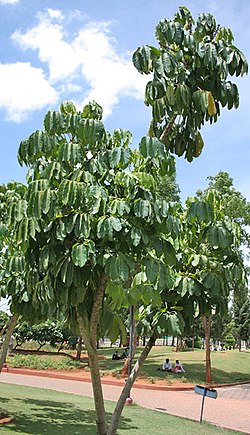| Habit | tree
| |
|---|---|---|
| Height: | ⇕ | 30 ft"ft" can not be assigned to a declared number type with value 30. |
| Width: | ⇔ | 12 ft"ft" can not be assigned to a declared number type with value 12. |
| Lifespan: | ⌛ | perennial |
| Bloom: | ❀ | early spring, mid spring, late spring, early summer, mid summer, late summer |
| Exposure: | ☼ | sun |
|---|---|---|
| Features: | ✓ | flowers |
| USDA Zones: | 10 to 12 | |
| Flower features: | ❀ | red, pink |
Schefflera actinophylla (syn. Brassaia actinophylla) is a tree in the Araliaceae family. It is native to tropical rainforests and gallery forests in Australia (eastern Queensland and the Northern Territory), New Guinea and Java. Common names include Umbrella Tree, Octopus Tree and Amate.
S. actinophylla is an evergreen tree growing to 15 m (49 ft) tall. It has compound medium green leaves in groups of seven leaves. It is usually multi-trunked, and the flowers develop at the top of the tree. It often grows as an epiphyte on other rainforest trees.[1] It produces racemes up to 2 metres (6.5 feet) long containing up to 1,000 small dull red flowers. Flowering begins in early summer and typically continues for several months.
The plant produces up to 1000 flowers generating large amounts of nectar which attracts honey-eating birds which then spread the seeds. The fruits are eaten by many birds and animals including Musky Rat Kangaroos, Red-legged Pademelons and Spectacled Flying Foxes.[2] Its leaves are a favourite food of the Bennett's Tree-kangaroo (Dendrolagus bennettianus).[3][4][5]
Cultivation
Schefflera actinophylla is commonly grown in mild to warm climates as a decorative tree in larger gardens and, when mature, it has bright red spikes of flowers with up to 20 racemes which develop in summer or early autumn. It prefers well-drained soil and only needs occasional watering and feeding to thrive. It is, however, an aggressive plant and its roots can dominate surrounding soil. In some areas (e.g., Florida & Hawaii USA) it is an invasive weed and therefore planting is highly unadvised.[6]
Propagation
Propagation is by seed or cuttings.
Pests and diseases
Varieties
Gallery
Rainbow Lorikeets feeding on Umbrella Tree
trunk in Hyderabad, India.
leaves in Hyderabad, India.
canopy in Hyderabad, India.
References
- Standard Cyclopedia of Horticulture, by L. H. Bailey, MacMillan Co., 1963
External links
- w:Umbrella Tree. Some of the material on this page may be from Wikipedia, under the Creative Commons license.
- Umbrella Tree QR Code (Size 50, 100, 200, 500)

